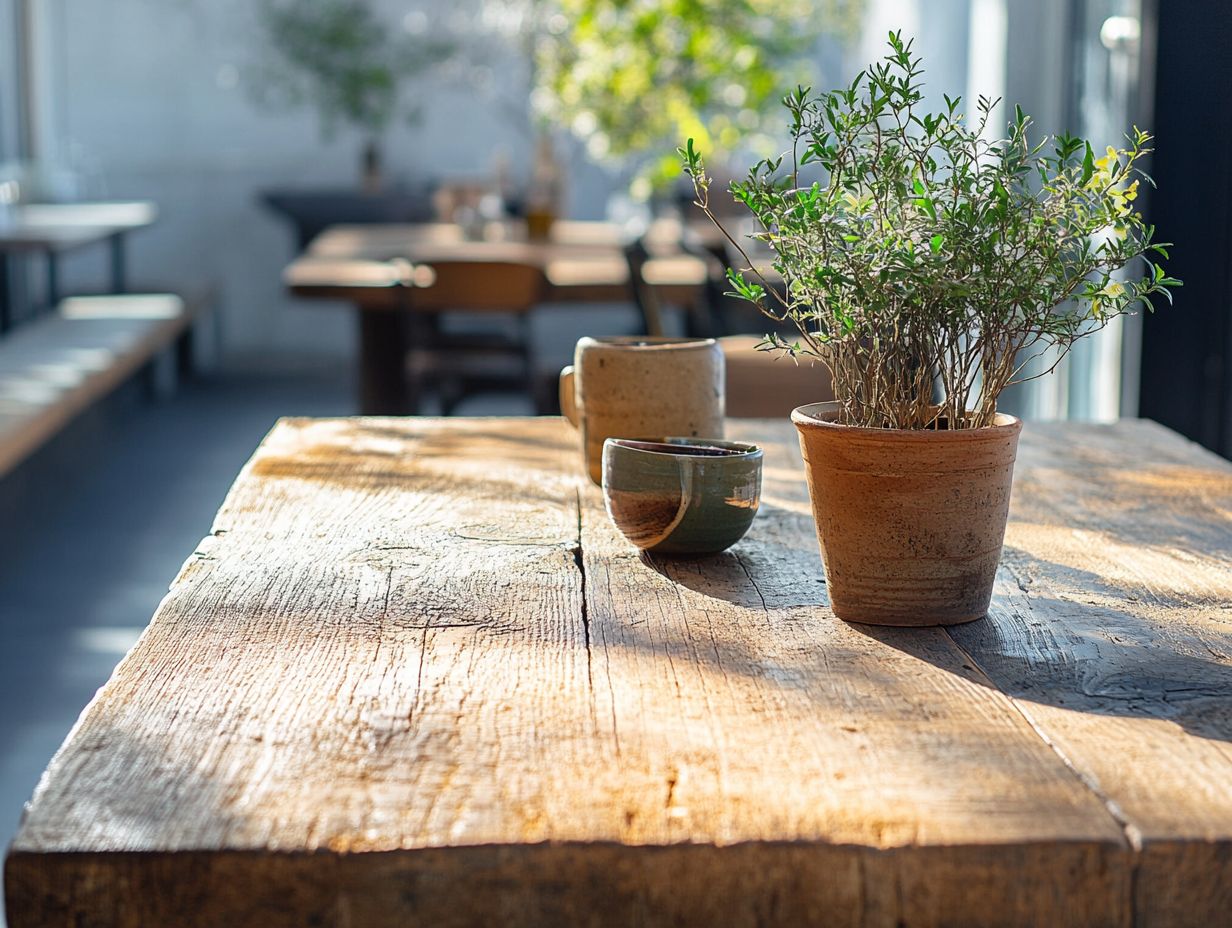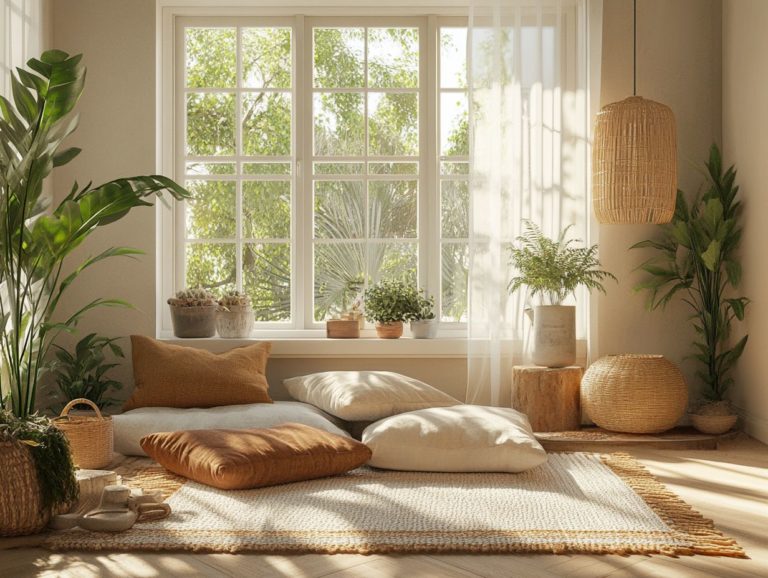Why Reclaimed Wood is a Sustainable Choice
Reclaimed wood transcends mere design trend; it embodies a sustainable choice that showcases your commitment to the environment.
Delve into the world of reclaimed wood and uncover its substantial environmental benefits, including its role in reducing deforestation and minimizing carbon footprints. Discover the exciting process of sourcing and preparing reclaimed wood, while also uncovering its aesthetic allure and practical advantages. Explore creative ways to integrate this unique material into your home.
Embrace the beauty and impact of reclaimed wood as you embark on a journey to transform your space sustainably! Don t miss out on the chance to make a difference!
Contents
- Key Takeaways:
- The Environmental Impact of Using Reclaimed Wood
- The Process of Reclaiming Wood
- Benefits of Choosing Reclaimed Wood
- How to Incorporate Reclaimed Wood into Your Home
- Frequently Asked Questions
- What is reclaimed wood and why is it considered a sustainable choice?
- How is reclaimed wood different from new wood?
- What are the environmental benefits of choosing reclaimed wood?
- Is reclaimed wood more expensive than new wood?
- Can reclaimed wood be used for all types of projects?
- How can I ensure the reclaimed wood I purchase is sustainable?
Key Takeaways:

- Choosing reclaimed wood is a powerful step towards reducing deforestation and protecting our planet!
- The sourcing and preparation process of reclaimed wood involves salvaging and repurposing old wood, giving it a new life and reducing waste.
- Not only is reclaimed wood environmentally friendly, but it also adds a unique and beautiful aesthetic to your home while being cost-effective and durable.
Understanding Reclaimed Wood
Reclaimed wood is timber salvaged from historical structures like barns and factories, allowing you to repurpose it for modern projects while retaining its unique character and rich history. This sustainable choice enhances the aesthetic appeal of your projects and fosters a deep emotional connection to the past. For home improvement enthusiasts like you who aim to reduce your carbon footprint, reclaimed wood serves as an eco-friendly option.
By opting for reclaimed wood, you play an active role in minimizing landfill waste and reducing the demand for newly harvested trees, all while promoting responsible forestry practices. Sourced from various places be it decommissioned buildings or old shipping pallets each piece tells its own story, adding a distinct charm and warmth to your spaces.
Its use aligns beautifully with design that connects us to nature, enriching both the aesthetic and emotional experience for everyone who inhabits those spaces. In a world increasingly focused on sustainability, reclaimed wood stands as a testament to craftsmanship and tradition, resonating powerfully with those who appreciate both style and conservation.
The Environmental Impact of Using Reclaimed Wood
Utilizing reclaimed wood makes a compelling statement in sustainable building practices. By opting for this resource, you significantly diminish the environmental impact often linked to conventional lumber sourcing, and considering options like recycled glass can further enhance your eco-friendly choices.
This choice aids in the battle against deforestation and plays a vital role in lowering your carbon footprint.
Reducing Deforestation and Carbon Footprint
By opting for reclaimed wood, you actively contribute to the reduction of deforestation and minimize your carbon footprint, aligning your efforts with environmentally sustainable practices that prioritize the health of our planet.
This approach involves using materials salvaged from old barns, industrial buildings, or even demolished homes. Not only does this preserve the unique aesthetic character of these resources, but it also prevents them from becoming landfill fodder.
Reclaimed wood often comes with Forest Stewardship Council (FSC) certification (an organization that ensures responsible forestry), which guarantees that it has been sourced responsibly. When you incorporate reclaimed wood into your projects, you significantly reduce the demand for new timber, helping to protect existing forests and maintain biodiversity.
Choosing reclaimed alternatives also means you re cutting down on the energy consumption linked to logging and processing new lumber, resulting in a more sustainable and environmentally friendly building practice.
The Process of Reclaiming Wood

The process of reclaiming wood involves meticulously salvaging timber from old structures, like barns and factories, and preparing it for reuse in contemporary construction. This approach highlights sustainable practices and pays homage to the material’s rich history.
Start your sustainable journey with reclaimed wood today!
How Reclaimed Wood is Sourced and Prepared
Reclaimed wood is sourced from various locations, such as old barns and factories. Here, it is carefully dismantled to prepare it for a new life in your modern building projects.
The sourcing process often involves salvaging wood from structures that have outlived their usefulness. This ensures that each plank tells its own story while minimizing waste.
This meticulous approach preserves the historical value of the wood and reduces the demand for new lumber, promoting sustainability within the construction industry.
Once extracted, the reclaimed wood undergoes preservation methods like drying and treatment to enhance its durability and resistance to pests. By utilizing this eco-friendly resource, you can enjoy numerous benefits. These include adding unique character to your designs, reducing your carbon footprint, and contributing to healthier indoor air quality. This makes reclaimed wood an exceptional choice for builders who prioritize environmental consciousness.
Benefits of Choosing Reclaimed Wood
- Sustainability
- Distinctive character
- Cost-effectiveness
- Remarkable durability
It’s the perfect choice for builders and homeowners who care about the environment and love unique architectural styles!
Sustainability and Aesthetics
Reclaimed wood embodies sustainability while presenting captivating aesthetics. It often becomes a striking focal point in design that connects people with nature.
When you choose salvaged timber, you’re not just minimizing waste; you’re infusing your spaces with unique character. Each piece carries its rich history and narrative.
This natural material adds warmth and texture, creating an inviting sense of comfort and serenity in any room.
Incorporating reclaimed wood into your design choices aligns seamlessly with eco-friendly practices and enhances air quality. It contributes to a healthier indoor atmosphere.
By bridging the divide between nature and urban living, this versatile material encourages reflection on your surroundings. It fosters deeper emotional ties to your spaces, ultimately elevating your overall well-being.
Cost-Effectiveness and Durability

Reclaimed wood isn t just a cost-effective option; it also offers remarkable durability. This makes it an astute choice for various building practices and long-lasting wood products.
This unique material, often sourced from old barns, factories, and even shipping crates, seamlessly combines historic charm with modern efficiency something traditional lumber simply can t compete with.
Builders and designers gravitate toward reclaimed wood because it stands the test of time. It often outlasts its newer counterparts while demanding less maintenance.
Its sustainable nature significantly reduces environmental impact by repurposing existing materials instead of contributing to deforestation. As the demand for eco-friendly solutions grows, reclaimed wood emerges not just for its visual allure, but for its economic and ecological advantages as well.
How to Incorporate Reclaimed Wood into Your Home
Incorporating reclaimed wood into your home elevates its aesthetic charm while championing sustainability. This choice enhances visual appeal and presents unique design opportunities for various construction projects.
You can express your personal style while remaining mindful of the environment.
Explore our collection of reclaimed wood and transform your space today!
Ideas and Inspiration for Design
Reclaimed wood opens a world of creative possibilities. Think stunning feature walls and rustic furniture that bring warmth and a nature-inspired beauty to your spaces.
This versatile material not only adds character and authenticity to any room but also champions sustainability by repurposing old wood that carries its own stories.
Whether you re a homeowner or a designer, you can explore a range of applications. Consider crafting kitchen islands from barn wood or installing shelving storage units that display items that highlight its rich textures.
Picture this: ceiling beams and paneling that transform a dull room into a cozy retreat, enhancing your connection to nature indoors. The advantages go beyond just looks; incorporating reclaimed wood fosters a sense of well-being, creating environments that nurture both your mind and body.
Frequently Asked Questions
What is reclaimed wood and why is it considered a sustainable choice?

Reclaimed wood is wood that has been salvaged from old buildings, structures, or other sources and given a new life. It is considered sustainable because it reduces the demand for new wood and helps to preserve natural resources.
How is reclaimed wood different from new wood?
Reclaimed wood has a unique character and history that cannot be replicated with new wood. It may have nail holes, knots, and other imperfections that give it a rustic and authentic look.
Using reclaimed wood reduces the need to cut down new trees, making it a more environmentally friendly option.
What are the environmental benefits of choosing reclaimed wood?
Choosing reclaimed wood helps to reduce deforestation and decrease the amount of wood waste in landfills. It also reduces the energy and resources needed for processing and transporting new wood products.
Is reclaimed wood more expensive than new wood?
The cost of reclaimed wood can vary depending on the source and type of wood. In some cases, it may be more expensive than new wood, but in others, it can be a more cost-effective option.
Ultimately, the value and uniqueness of reclaimed wood make it a worthwhile investment.
Can reclaimed wood be used for all types of projects?
Yes, reclaimed wood can be used for a variety of projects, from furniture and flooring to home decor and construction. It is a versatile material that can add character and charm to any space.
How can I ensure the reclaimed wood I purchase is sustainable?
When purchasing reclaimed wood, it is important to do your research and buy from reputable suppliers. Look for certifications or labels that indicate the wood has been sourced sustainably.
You can also ask the supplier about the source of the wood and their practices for salvaging and processing it.






